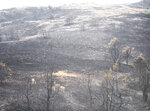GUERNSEY – While a burn scar remains across much of the land where Pleasant Valley Fire challenged the ingenuity and resourcefulness of firefighters earlier this summer, the long-term impact …
This item is available in full to subscribers.
To continue reading, you will need to either log in to your subscriber account, below, or purchase a new subscription.
Please log in to continue |


GUERNSEY – While a burn scar remains across much of the land where Pleasant Valley Fire challenged the ingenuity and resourcefulness of firefighters earlier this summer, the long-term impact isn’t so dire. At least for wildlife.
The fire, which consumed an area of nearly 29,000 acres in northeast Platte County and western Goshen County, burned varied swaths of grass, brush, and some lightly forested areas. Firefighters were able to save most lived-in structures, with only one home loss, which was unoccupied at the time and posed a risk for firefighters where it was situated with only one way in or out. However, some outbuildings were consumed by the fire – a necessary choice in the broader scheme of things, considering the scale and nature of the fire, according to Guernsey Rural Fire District chief David Warner.
Just after the fire was suppressed, the clouds opened up with some much-needed rain, causing some grasses and forbs to sprout green shoots, which is a benefit to the land in preparation for winter weather and to prevent erosion of soil. Those green shoots are also good for wildlife.
As local Wyoming Game and Fish wildlife biologist, Keaton Weber, said, the local deer and pronghorn populations should benefit from the late summer/early fall green-up. He said it has been documented doe’s benefit from the extra nutrition and fattening heading into the lean winter months, and usually result in higher survivability rates for their fawns in spring.
Wildlife trails still cross the burned areas and deer can still be spotted munching on available forage, and “a lot of wildlife utilize burn scars post-fire,” Weber said, but reported there have been movements of local herds. Pronghorn were displaced after the fire to the east and northeast, when they typically move that direction in November. Though there isn’t a high-density mule deer population, the herd has moved generally south to the river or northwest of highway 270 where there is better habitat. Local flocks of turkeys moved south towards the river or west towards the state park. Some elk, which spend time near Garnet Mountain east of Whalen Canyon Road, also likely moved west.
Weber also gave another benefit of the fire: it burned a lot of old-growth brush and stands of invasive juniper trees. Weber explained the junipers encroach on stands of native ponderosa pine and aspen groves and out-compete them. “The fire does a good job of [taking out] juniper, and when they are gone, we usually see historic springs come back” he added. Those springs in turn bring another habitat resource for wildlife, and with the old growth gone it lets in more light, a benefit for a variety of native forage.